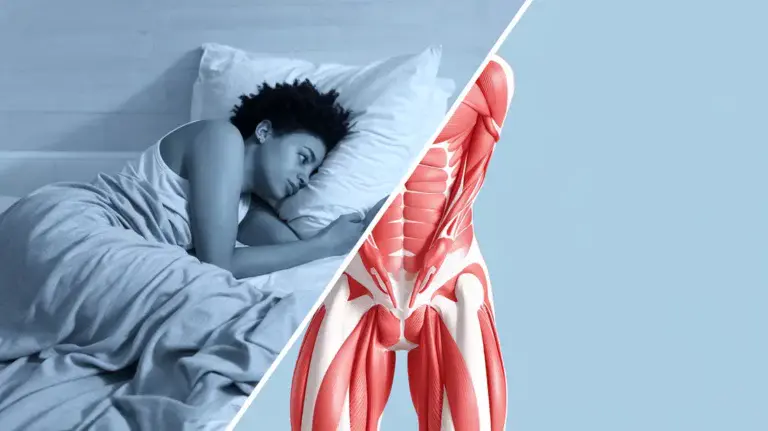Are you experiencing persistent lower back pain that just won’t go away, despite trying various treatments?
The culprit might be hiding in plain sight – your tight hip flexors.
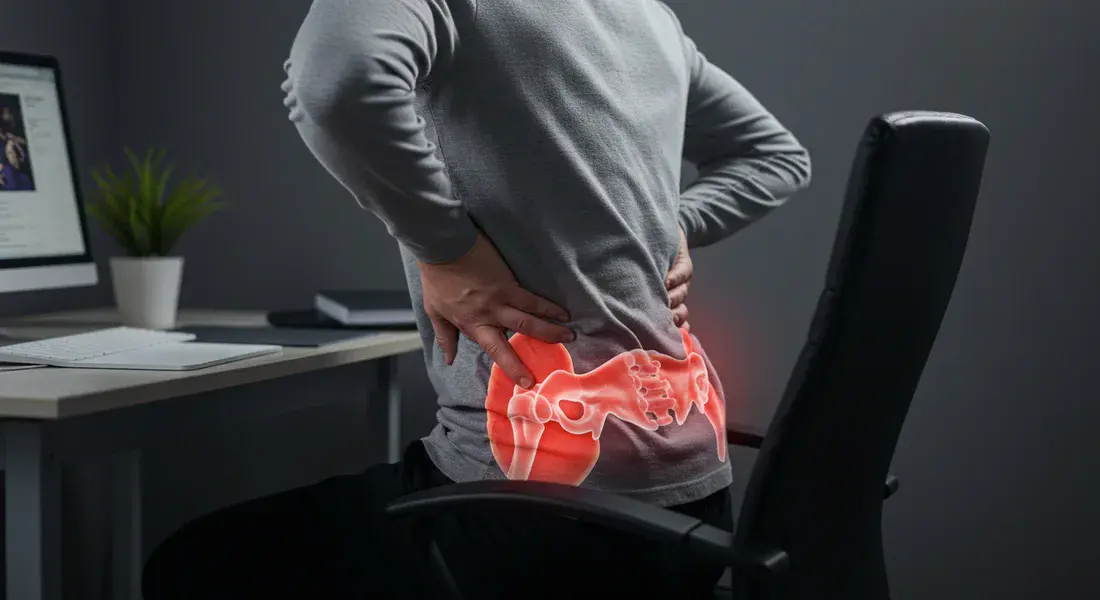
Often overlooked, these muscles can be a significant source of lower back pain, impacting your posture, mobility, and overall well-being.
In this comprehensive guide, we’ll unravel the hidden connection between tight hip flexors and lower back pain, exploring how these muscles influence your body and, most importantly, providing effective strategies to release tension and find relief.
Addressing this often-overlooked connection is essential for sustained comfort and improved quality of life.
What are Hip Flexors? The Engine of Your Movement
Hip flexors are a group of muscles located at the front of your hip, playing a pivotal role in lower body movement.
They enable you to bend at the hips, lift your knees, and walk, run, and perform countless other everyday activities.
Understanding their function is the first step to appreciating their impact on your back.
The primary hip flexor muscles include:
- Iliopsoas: Often considered the most powerful hip flexor, the iliopsoas is actually a combination of two muscles: the iliacus and the psoas major. The iliacus originates from the iliac fossa (the inner surface of the hip bone), while the psoas major originates from the lumbar vertebrae (lower spine). They merge and insert onto the lesser trochanter of the femur (thigh bone).
- Rectus Femoris: This is part of the quadriceps muscle group, located at the front of your thigh. Unique among the quads, the rectus femoris crosses both the hip and knee joints, contributing to both hip flexion and knee extension.
- Sartorius: This long, slender muscle runs diagonally across the front of your thigh, from the outside of your hip to the inside of your knee. It’s the longest muscle in the human body and assists in hip flexion, abduction (moving the leg away from the midline), and external rotation (turning the leg outward).
- Pectineus: This small, flat muscle is located in the inner thigh and assists with hip flexion, adduction (moving the leg toward the midline), and external rotation.
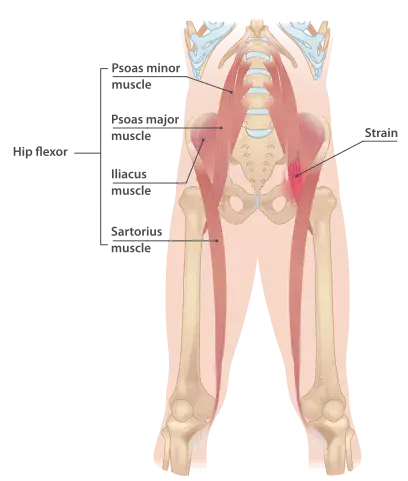
The Connection Between Tight Hip Flexors and Lower Back Pain – A Vicious Cycle
Tight hip flexors are more than just a muscle issue; they can create a cascade of problems that ultimately lead to lower back pain.
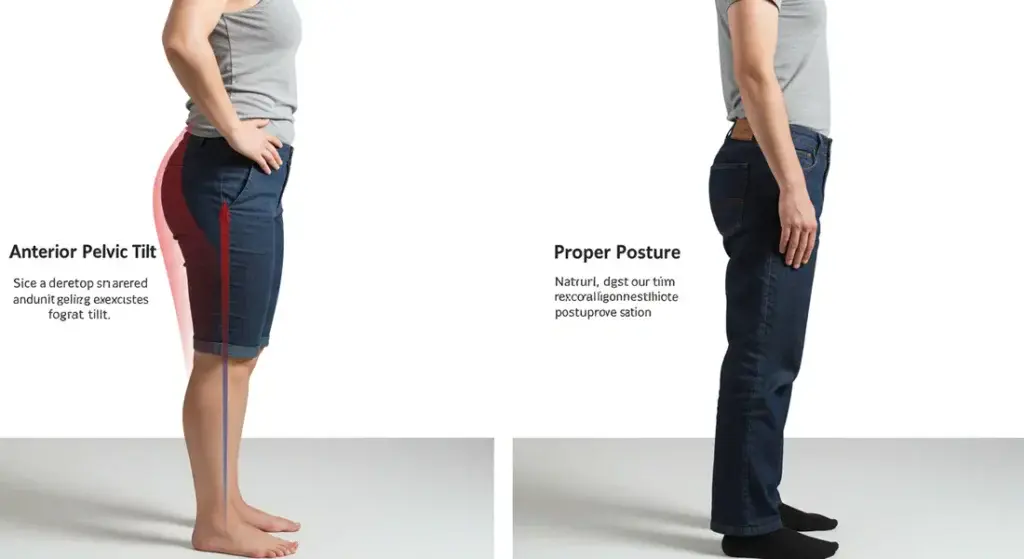
Several factors contribute to this connection:
- Prolonged Sitting: In today’s world, many people spend hours sitting at desks, in cars, or in front of screens. This prolonged sitting causes the hip flexors to remain in a shortened position, leading to tightness and reduced flexibility.
- Anterior Pelvic Tilt: Tight hip flexors pull the pelvis forward into an anterior tilt, causing an exaggerated arch in the lower back (increased lumbar lordosis). This misalignment puts extra stress on the facet joints (the small joints in your spine) and the surrounding muscles and ligaments, leading to pain and discomfort.
- Compromised Posture: Anterior pelvic tilt affects overall posture, leading to rounded shoulders, a forward head position, and other postural imbalances that contribute to back pain.
- Reduced Range of Motion: Tight hip flexors limit your ability to fully extend your hip joint, affecting your gait (walking pattern) and restricting your range of motion during everyday activities.
- Impact on Running Performance and Injury Risk: For runners, tight hip flexors can shorten stride length, decrease running efficiency, and increase the risk of injuries such as hamstring strains, IT band syndrome, and knee pain.
Symptoms of Tight Hip Flexors – Recognizing the Signs
Identifying tight hip flexors early is crucial for preventing chronic lower back pain.
Be aware of these common symptoms:
- Lower back pain, often described as a dull ache or stiffness
- Hip pain, particularly in the front of the hip joint
- Stiffness in hips and back, especially after prolonged sitting
- Limited range of motion in the hips
- Poor posture, with an exaggerated arch in the lower back
- Difficulty walking or running, feeling like the hips are “locked up”
- Joint pain in the back, hips, knees, and legs due to compensatory movement patterns
- Difficulty sleeping due to discomfort and muscle tension
Benefits of Stretching Hip Flexors – Reclaiming Your Mobility and Comfort
Fortunately, stretching tight hip flexors offers numerous benefits, alleviating lower back pain and improving overall well-being:
- Improved Mobility: Releasing tension in the hip flexors restores a more natural range of motion, allowing you to move with greater ease and efficiency.
- Reduced Pain and Stiffness: Stretching helps lengthen the hip flexor muscles, reducing pressure on the lower back and alleviating pain and stiffness.
- Improved Posture: Releasing tight hip flexors helps restore proper pelvic alignment, leading to improved posture and reduced strain on the spine.
- Increased Flexibility: Regular stretching increases the flexibility of the hip flexor muscles, making everyday activities easier and more comfortable.
- Better Athletic Performance: Improved hip flexor flexibility and strength can enhance running stride, increase power output, and reduce the risk of injuries.
- Injury Prevention: By addressing tight hip flexors, you can prevent a cascade of problems that lead to lower back pain and other musculoskeletal issues.
Effective Hip Flexor Stretches – Releasing the Tension
Before starting any stretching routine, it’s important to warm up your muscles with light cardio or dynamic movements.
This will increase blood flow and prepare your muscles for stretching.
Here are some effective hip flexor stretches you can incorporate into your daily routine:
- Kneeling Hip Flexor Stretch:
- How to perform: Start in a half-kneeling position with your right knee on the ground and left foot planted in front. Keeping your torso upright, gently push your hips forward until you feel a stretch in the front of your right hip. For a deeper stretch, raise your right arm overhead and slightly lean to the left.
- Hold: 30 seconds, repeat 2-3 times on each side
- Standing Hip Flexor Stretch:
- How to perform: Stand tall with feet hip-width apart. Take a step back with your right foot, keeping your heel raised. Bend your left knee slightly while keeping your right leg straight. Push your right hip forward while maintaining an upright torso.
- Hold: 30 seconds, repeat 2-3 times on each side
- Active Hip Flexor Stretch:
- How to perform: Start in a lunge position with your right knee on the ground and left foot planted in front. Place your hands on your left thigh for support. Engage your right glute and push your hip forward. Maintaining this position, lift your right knee slightly off the ground for 2 seconds.
- Lower and repeat: 10 times before switching sides
- Supine Hip Flexor Stretch:
- How to perform: Lie on your back near the edge of a bed or bench. Bring both knees toward your chest. Hold your right knee close while allowing your left leg to hang off the edge. Gently lower your left leg, feeling the stretch in the front of your hip.
- Hold: 30 seconds, repeat 2-3 times on each side
- Seated Hip Flexor Stretch:
- How to perform: Sit at the edge of a chair with feet flat on the floor. Extend your right leg behind you, keeping the ball of your foot on the floor. Keeping your spine straight, lean forward slightly from the hips.
- Hold: 30 seconds, repeat 2-3 times on each side
- Prone Hip Flexor Stretch:
- How to perform: Lie face down on a mat. Bend your right knee to a 90-degree angle. Grab your right ankle with your right hand. Gently pull your heel toward your glute.
- Hold: 30 seconds, repeat 2-3 times on each side
- Lunges:
- How to perform: Stand tall with feet together. Take a large step forward with your right foot. Lower your body until both knees are bent at 90-degree angles.
- Repeat: with the left leg. Continue alternating for 10-12 repetitions per side
- [Insert Image or Video of Prone Hip Flexor Stretch]
- Dynamic Lunges:
- How to perform: This functional movements help improve mobility while mimicking the running motion.
- Repeat: Continue alternating for 10-12 repetitions per side
- [Insert Image or Video of Prone Hip Flexor Stretch]
Hip Flexor Strengthening Exercises – Building a Strong Foundation
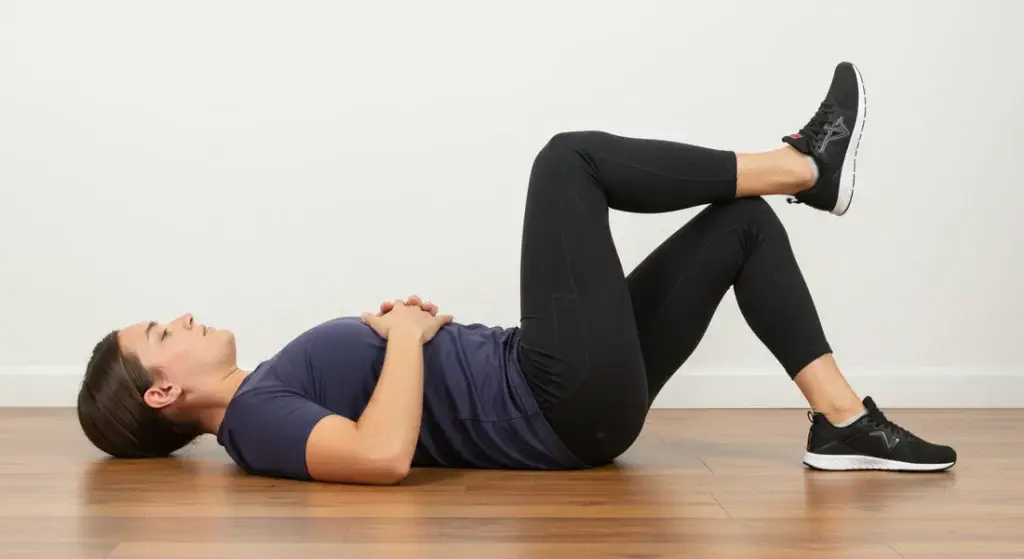
While stretching is important for releasing tension, strengthening your hip flexors and the surrounding muscles is crucial for maintaining proper alignment and preventing future problems.
Incorporate these exercises into your routine 2-3 times per week:
- Straight Leg Raises:
- How to perform: Lie on your back, keep one leg bent with foot flat on the floor, and lift the other leg straight up to 45 degrees.
- Repeat: 10-15 times for 2-3 sets on each leg
- [Insert Image or Video of Straight Leg Raises]
- Bridges:
- How to perform: Lie on your back with knees bent, lift hips toward the ceiling by engaging glutes and core.
- Hold: for 2-3 seconds at the top.
- Repeat: 10-15 times for 2-3 sets.
- [Insert Image or Video of Glute Bridges]
- Mountain Climbers:
- How to perform: From a plank position, alternately drive knees toward chest in a controlled running motion.
- Perform: 30-60 seconds for 2-3 sets.
- [Insert Image or Video of Mountain Climbers]
- Psoas March:
* How to perform: Lying on your back, place both hands on the stomach. Slowly bend your hip up to your chest. Then, bend your knee and slowly return to your starting position. Then repeat with the opposite leg- Repeat: Hold for 2 to 3 seconds, and repeat 10 -15 times for 2 to 3 sets.
- [Insert Image or Video of Psoas March]
Additional Tips for Hip Flexor Health – Lifestyle Integration
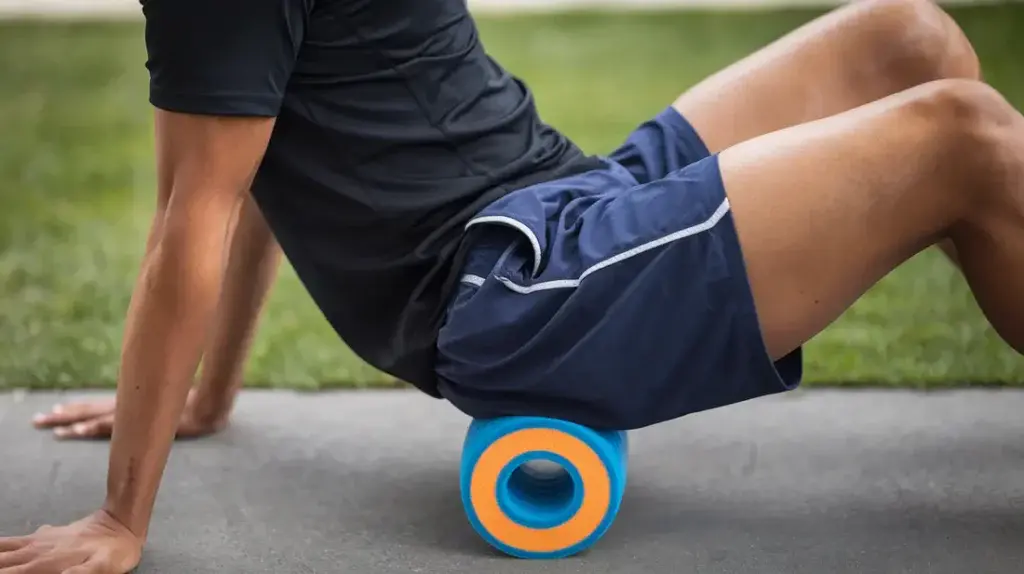
Beyond stretches and exercises, several other practices can contribute to hip flexor health:
- Foam Rolling Techniques for Hip Flexors:
- Use a foam roller to release tension in the hip flexors and surrounding muscles.
- Lie face down with the foam roller positioned at the top of your thigh.
- Support some of your weight on your forearms.
- Slowly roll down the front of your thigh, pausing on tender spots for 20-30 seconds.
- Breathe deeply and feel the muscle gradually release.
[Insert Image or Video of Foam Rolling Hip Flexors]
- Proper Posture Practices:
- Sit with feet flat on the floor and knees at hip level or slightly lower.
- Use a lumbar support or rolled towel to maintain the natural curve in your lower back.
- Consider a standing desk or adjustable workstation to vary your position.
- Set posture check reminders on your phone or computer.
[Insert Image of Good and Bad Sitting Posture]
- Regular Movement Breaks:
- Stand up and move at least once every hour.
- Take phone calls standing or walking.
- Use a timer to remind yourself to change positions regularly.
- Take the stairs instead of the elevator.
- Park farther from destinations to incorporate more walking.
[Insert Image of Someone Taking a Movement Break at Their Desk]
Addressing Common Issues and Concerns – What to Expect
- What to Do If You Experience Pain:
Stop any stretch or exercise that causes sharp pain.
Apply ice to inflamed areas for 15-20 minutes.
Consider consulting a physical therapist for persistent issues.
Don’t push through pain—modify stretches or seek professional guidance. - How Long Does It Take to See Results:
Noticeable improvements in flexibility often occur within 2-3 weeks of consistent stretching.
Significant changes in running form and performance typically emerge after 4-6 weeks.
Some runners with severe restrictions may need several months of dedicated work.
Progress is rarely linear—be patient with plateaus and celebrate small victories.
The key is consistency. Five minutes of daily stretching will yield better results than an occasional 30-minute session. - Can Stretching Too Much Be Harmful:
Overstretching can lead to muscle instability or hypermobility.
Always warm up before deep stretching.
Listen to your body—stretching should never cause sharp pain.
Balance flexibility work with appropriate strength training.
Quality trumps quantity—proper technique is more important than duration.
Conclusion – Reclaim Your Comfort and Well-being
Addressing tight hip flexors is an investment in your long-term health and comfort.
By incorporating these stretches, exercises, and lifestyle modifications into your daily routine, you can prevent lower back pain, improve your posture, and enhance your overall quality of life.
Remember that consistency is key.
Even small, daily efforts can make a significant difference in reclaiming your mobility and well-being.
Start today, and your body will thank you for it!
Remember: This article provides general information and is not a substitute for professional medical advice. If you’re experiencing persistent or severe pain, please consult a healthcare professional.
References
- Niemuth PE, Johnson RJ, Myers MJ, Thieman TJ. Hip muscle weakness and overuse injuries in recreational runners. Clin J Sport Med. 2005 Jan;15(1):14-21. doi: 10.1097/00042752-200501000-00004. PMID: 15654186.
- Siccardi MA, Tariq MA, Valle C. Anatomy, Bony Pelvis and Lower Limb: Psoas Major. [Updated 2023 Aug 8]. In: StatPearls [Internet]. Treasure Island (FL): StatPearls Publishing; 2025 Jan-. Available from: https://www.ncbi.nlm.nih.gov/books/NBK535418/
- Boukabache A, Preece SJ, Brookes N. Prolonged sitting and physical inactivity are associated with limited hip extension: A cross-sectional study. Musculoskelet Sci Pract. 2021 Feb;51:102282. doi: 10.1016/j.msksp.2020.102282. Epub 2020 Oct 28. PMID: 33188982.
- Butte KT, Cannavan D, Hossler J, Travis C, Geiger J. The relationship between objectively measured sitting time, posture, and low back pain in sedentary employees during COVID-19. Sport Sci Health. 2023;19(1):259-266. doi: 10.1007/s11332-022-01031-x. Epub 2022 Dec 24. PMID: 36590365; PMCID: PMC9789514.



